#versailles role play
Text

Is anyone interested in some MonChevy role play? Paragraph form on discord only. I am willing to play either The Chevalier or Philippe, either are fine with me. Interact with this or send me a message to express interest.
#monchevy#monchevyroleplay#monchevy RP#monchevy role play#the chevalier#versailles tv#versailles role play#versailles rp
14 notes
·
View notes
Text
Takarazuka Revue is so funny because it’s like we are a fine upstanding institution of good family values, like homophobia. Please ignore the lesbians making up the majority of people both on stage and in the audience.
Takarazuka Revue is like: we enforce only the strictest gender roles in our troupe as is right and proper, sorting them into the two genders: women who are women, and women who are men. How dare you suggest there’s anything queer about that.
Takarazuka Revue is simultaneously the queerest thing and the least queer thing to ever exist. Takarazuka bucks tradition and is tradition incarnate. Takarazuka is like




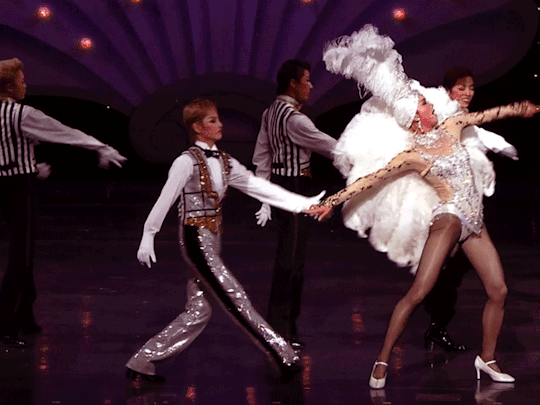
and then is like, “no homo”
and maintains itself as one of the most hierarchical artistic organizations in the world with intense control over its performers. This alternate reality where the talented (and lucky, and connected) few can gain the right to openly perform queerness in the one setting comphet capitalism has carved out for them as long as they follow a different even stricter set of rules for dress and behavior. It dissembles traditional gender by its very existence and so must reinforce it at every turn.
And yet despite being the product of a conservative capitalist railroad owner who only really sought to exploit women for entertainment aimed at men (and their hetero families) that remains loyal to those deeply normative puritanical roots, it was and is also one of the most liberating theater and media experiences of queer Japanese people for decades. You can tell from all the queer art about it, by queer people. By the fact that the audience who flocked to it were not (cis) men.
Trying to untangle the mutual influence of shoujo manga to takarazuka is even more difficult that trying to untangle something like the history of modern Broadway and Disney movies. We wouldn’t have The Little Mermaid without Little Shop of Horrors, but we wouldn’t have Wicked without the Disney renaissance, but we wouldn’t have Frozen without Wicked, and going back further to things like Cinderella and Rogers and Hammerstein and they are intertwined but listen to me. Takarazuka and shoujo manga, especially yuri, are more intertwined. And then so much western media has been inspired by shoujo anime. Rose of Versailles the manga was inspired by Takarazuka and then in turn was adapted into their most famous play which then in turn influenced so many more artworks. Uranus and Neptune are an otokoyaku and musumeyaku. Utena and Anthy (and honestly that whole ass show. The stairs?? C’mon). And all the works and creators THOSE works inspired.
We owe so much to Takarazuka but also if we tried to thank them for their role in queer history they’d be like “we’ve never been queer in our lives!!!!!!!!” and then say a slur to your face while taking your money. Incredible. Wish more people knew what the fuck it was and I could get fansubs.
6K notes
·
View notes
Text
Transmasculinity and queer sexuality in the works of Ikeda Riyoko
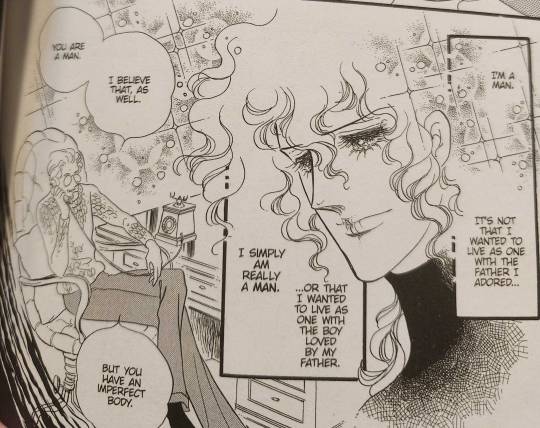
Content Warning: Discussion of transphobia and suicide
Spoilers for Dear Brother, The Rose of Versailles, and Claudine
Ikeda Riyoko—perhaps the most famous member of the “year 24 group” that played a large part in creating the foundations of the shoujo manga genre—is often credited with laying the groundwork for depictions of queer characters in shoujo, and in particular with creating the archetype of the gender-bending heartthrob heroine, or “girl prince.” Building on earlier representations of butch or transmasculine characters in early shoujo manga such as Princess Knight, and the Takarazuka theater tradition of the otokoyaku male role actor, Ikeda’s enormously popular gender non-conforming heroes—Lady Oscar from The Rose of Versailles, Rei from Dear Brother, Julius from the Window of Orpheus, and the titular character of Claudine—helped to establish that there was a major mainstream audience excited to cheer for a hotheaded, androgynous tomboy with a heart of gold. Lady Oscar in particular has fingerprints all over the history of anime and manga, from a gender-bending cameo in Pokémon to serving as the inspiration for iconic characters like Tenjou Utena.
When I first read The Rose of Versailles last year, I expected its depictions of queer and transmasculine characters to be somewhat limited—after all, the comic was written for mainstream audiences and a mainstream publisher in the 1970s. But across Ikeda’s work, I was deeply surprised with the level of care and nuance with which Ikeda approaches transmasculine love stories. While there is obviously a lot about Ikeda’s portrayal of transmasculine characters that feels dated to modern audiences (for example, her comics often do fall back on “biological” ideas of women’s weakness and emotionality, and sometimes psychologize her character’s genders in uncomfortable ways), I was surprised by how much of these comics still hit for me today. What makes them work for me is both the extreme pathos with which Ikeda writes transmasculine character’s experiences of rejection—and, at rare moments, gender euphoria —but also the fact that her trans characters are not simply given a one-size fits all born-in-the-wrong-body narrative. Instead, they are each portrayed as unique individuals with varied personal relationships to their gender, their sexuality, and the historical context of the society they live in.
Read it at Anime Feminist!
#riyoko ikeda#ryoko ikeda#rose of versailles#berubara#versailles no bara#lady oscar#dear brother#oniisama e#claudine#classic shoujo#shoujo#articles#asuka rei
333 notes
·
View notes
Text
Masterpost: Visual Kei movies & other types jrockers were involved
So, it came to my attention some of you want to watch more visual kei movies so I thought of listing what I know, in case you've missed any of those. Please feel free to add anything I've missed with reblogs or in the comments.
Thank you @kirk-goes-to-gallifrey for the three movie links! ^^ And thank you @waretamado for helping with the titles of Plastic Tree's movies! Btw most of the vkei only movies must still be available on YT guys, however not all of them will be on HD.
Visual Kei movies:
Seth et Holth (1993) (Hide)
YT link (https://www.youtube.com/watch?v=Vx_laJCEpew)
Moon Child (2003) (Gackt & Hyde)
Verte Aile/Bel Air (1997) (Malice Mizer)
YT link (https://www.youtube.com/watch?v=Vdd58pTaK8A)
Bara no Konrei/Bridal of the Rose (2001) (Malice Mizer)
YT link (https://www.youtube.com/watch?v=Tr1d_cFRnxs)
BeatRock☆Love (2009) (Takeru ex.SuG)
Number Six (2006) (Alice Nine)
Yuku Pura Kuru Pura... Edokawa Puranpo no 「Ougon otoko」~「Visual bako no bijo」 (Plastic Tree)
YT link (https://www.youtube.com/watch?v=81Bb-3L4l2E)
Yuku Pura Kuru Pura... Edokawa Puranpo no 「Onan tokage」~「Bishounen wo kuu bijo」 (Plastic Tree)
YT link (https://www.youtube.com/watch?v=wAha6vDCE0Q)
Yuku Pura Kuru Pura...Edokawa Puranpo no「Angura Kaijin」~「Remon no bijo」 (Plastic Tree)
YT link (https://www.youtube.com/watch?v=Pzt3ai5LSXc)
Ascendead Master (2009) (Versailles)
Onegai Kanaete (2011) (Versailles)
Oresama (2004) (Miyavi)
YT link (https://www.youtube.com/watch?v=NcBvKQfVKNM)
Non Visual Kei movies jrockers acted in:
Kagen no Tsuki (2004) (this is a live action of a manga) (Hyde)
There is a movie that Takeru of SuG had played in for only a couple of scenes that was his first ever role, but I forget the name. I remember sth about "blue generation" or sth. If sb remembers it, please put it in the comments. Most people might remember the scene with the fluffy coat, him with blond hair turning to the protagonist with a menacing look, from the distance.
Paracelcus' Homonculus (2015) (this is an artsy film based off a photographer's exhibition) (Takeru of SuG)
Midori: the Camellia girl (2016) (live action of a manga) (Takeru of SuG)
Bunraku (2010) (Gackt)
Akumu-chan (2014) (Gackt)
Karanukan (2018) (Gackt)
Tonde Saitama 1 (2019) & 2 (2023) (Gackt)
Moshimo Tokugawa Ieyasu ga Sori Daijin ni Nattara (2024) (Gackt)
Furin Kazan (2007) (Gackt)
Mr. Brain (2009) (it must have been 1 episode or 2) (Gackt)
Tempest (2011) (Gackt)
Sengoku Basara (2012) (Gackt)
Time Spiral (2014) (Gackt)
BLEACH (2018) (live action) (Miyavi)
Hell Dogs (2022) (Miyavi)
Familia (2023) (Miyavi)
Maleficent: Mistress of Evil (2019) (Miyavi)
Kate (2021) (Miyavi)
Stray (2019) (Miyavi)
Unbroken (2014) (Miyavi)
There's a movie with either gangs or bands that Chiyu of SuG played after the disband. Papiko, shed your light cause I don't remember the title.
Other
REPO! The Genetic Opera (2008) (Yoshiki was involved with the music production of this film. Personally I learnt it years after I'd watched it)
Death Trance (2005) (It features many Dir en Grey songs in its soundtracks)
I hope you can find anything you like and enjoy!
#visual kei#vkei#visual kei movies#hide#x japan#versailles#malice mizer#gackt#miyavi#takeru#hyde#l'arc en ciel#vamps#alice nine#plastic tree#chiyu#sug
97 notes
·
View notes
Note
how would you interpret Maria hugging hunter in her visceral? i always thought of it as some sort of mockery from her
Sort of, but in the way that her whole fight is sort of a "mockery" of the concept of a dashing Heroic romance (In the Shakespearean sense of the term). Let me explain.
First, we have to understand Maria's character design in that she is of the bifauxnen archetype. The bifauxnen is a handsome, gentleman-ly type woman portraying all the traits we associate with a dashing hero: courageous, refined and sometimes aristocratic, and androgynous. She is the counterpart to the bishonen, the contrast to the more coarse Lad-ette. The most famous of this archetype of course is Lady Oscar from Rose of Versailles. She is essentially a Female Prince.
The Lady Maria reflects this design. Out of all the Hunters and Byrgenwerth crew, she is the one dressed to the Nines, wearing dashing Cainhurst fashion to something that is essentially nasty and wet and all the other things (the Hunt). She's wearing jewelry (the Lumenflower brooch) the cravat, the fact she curls her hair, the aristocratic looks and backstory (the fact that she's the Lady Maria, a Knight of Cainhurst Vileblood royalty), the fact that she was the one taking care of the Research patients and they worship her, etc. Her outfit fits along the lines of the Lady Oscars, Alucards, and so forth. The fact that she is the only one to realize the atrocity of her actions, to regret her actions and reject her calling as a Hunter, is so fucking introspective at the cost of noticing Gehrman's mania for example reads very much in line of a Romantic hero. She is presenting a Look and this Look says she is meant to come off as rich, handsome, and heroic as she's slaying monsters. At least, those are the visual cues the player is meant to read in that sense. And that is carried over into her actions.
Lady Maria fights the Hunter to "liberate [them] from [their] wild curiosity" - she is taking the role again, of the hero. The villain here, being that need for Insight and she is saving the Hunter from the call of blood. She then engages you a fight, a dance really, set to waltz - again, playing with those romantic hero tropes (assuming you don't parry her to death). The visceral attack therefore, plays into that fantasy. She treats you so gently cause of course you are the Victim enslaved by your thirst for knowledge, she is the romantic hero, mercy killing you with the sweet kiss of death. She steadies you as your now heartless body bleeds out onto the floorboards of the clocktower.
But like everything in Bloodborne, there is a catch you see. Cause the Lady Maria is not a hero in fact; she is a bloody coward.
Yes, Maria is the only member of the Byrgenwerth crew (and amongst the few Hunter in general) to make a dry stop + u-turn from the Hunt and the atrocities associated with that. But unlike someone like Djura, who at least is trying to be productive in his redemption, Maria runs from her mistakes. She casts Rakuyo into the Well and leaves. She joins the Research Hall and contributes to more atrocities there, but hey at least all the patients there love her right?? (😬) And when her brooding (or maybe insanity? who says she was immune to the Beast plague? Or Kos infecting her brain??) was too much for her, she takes her own life instead of you know, working to dismantle the systems - both the Research Hall and the Hunt itself. Her issues and her guilt - that is more important to her than actually helping or saving people. She the Lady Maria of the Astral Clocktower, Lord over nothing else but the reminder of her greatest failure. Both in life and in death.
Cause you see, her stopping the Hunter isn't really about saving them from their wild curiosity. The Fishing Hamlet is dead and gone. The effects are echoing throughout all of Yharnam in this day and age. Heck, the Hunter just came in from the Research Hall itself. It is well and truly Known, to prevent future atrocities of that scale, one has to know the events that led to those atrocities in the First Place. Lady Maria isn't helping you, isn't saving you from anything you already knew to begin with. She is, once again, trying to alleviate her own guilt and shame and trying to prevent others of knowing of that shame. So she tries to kill you. But you know, in a Heroic way. Hence why the whole fight is a sham and mockery.
She also hates your guts. I consider this to be tertiary canon at best, but the deleted lines has it so that she calls you insufferable, and baits you to kill her. She Does Not Actually Give a Shit About You. It cannot be more blatant than that. And how couldn't she? You make her recall her greatest shame, force her to break the last of her principles (no Vilebloodbending) so that your ass does not learn of what she's done. You also keep coming back, so you're a constant reminder that no matter what she does, her actions really do mean nothing, not before, and definitely not now.
Also she stares at you like this the whole fight if looks could kill well, you would be dead and not coming back (The way you ought to. Bastard. Stay dead already!! - Lady Maria, probably):

So yeah, she is mocking you with a oh so sweet kiss from the Handsome Hero type as she rips your heart out (breaking it) and kills you very dead. Cause fuck the Hunter specifically.
#lady maria of the astral clocktower#bloodborne#my meta#me shaking Maria: YOU ARE SO STINKY!!! RATTY BASTARD#Also there is something to be said about how she cries out to the Moon Presence like Gehrman does when she's killed#but she never actually Made Contact with Her#Crying out to a God who is Deaf to Her#as she's dragged to Kosm Hell where she belongs!!#so yeah
89 notes
·
View notes
Note
Hi! I'm on a regency binge at the moment and while Good Society is on my list, do you have any more regency games/systems to recommend?
THEME: Regency Games
Hello friend, I think I have a nice little selection for you to take a look at!
One thing to note is that some of these games are very gendered, providing roles such as “Matron”, “Nobleman” or “Countess” that is rather unavoidable. Sometimes this is simply part and parcel of playing in a specific era of history, and sometimes it is done purposefully, as games can often be commentary about certain issues that were prevalent at the time.
While I think you could likely make a non-binary character in these games if you really want to, I think that one of the appeals of playing in the Regency era is the strict social structures that created such rigid gender boundaries, and so I’m not surprised to see those boundaries enforced in these games.
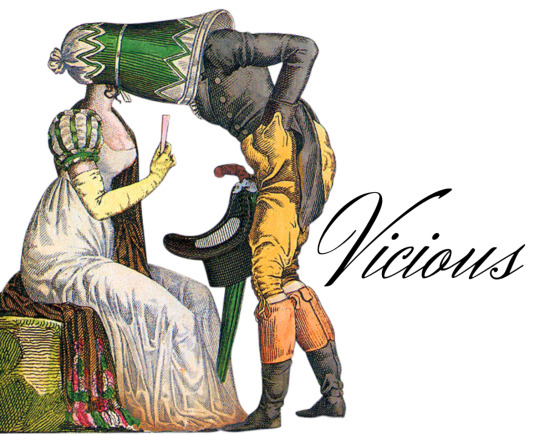






Vicious, by Budget Versailles.
Vicious is a game set during the Regency period about scandalous gossip told via letters between three or more players.
Players roll dice to generate scenarios and gossipy twists to pass on to the next player until everyone has been deceived with shocking slander and hearsay.
If you’re a fan of the epistolary phase of Good Society, Vicious is probably worth looking at. Watch a piece of news twist out of your control as your letters get flavoured with gossip. You can roll for inspiration for various scenarios, as well as for juicy gossip to make those scenarios even better - but the game ends with one player sends out an invitation to determine how many of the accusations that have been sent around are true.
I think Vicious is also an excellent add-on to pair with another game of your choice, especially since it could be played in between sessions, cooking up drama for the players to hash out in an in-person confrontation.
Hazelwood Abbey, by stevehatherly.
Downton Abbey meets Hillfolk. Players play an aristocratic family in a player-led dramatic game of emotional needs and wants for 4-5 players.
Hazelwood Abbey uses Pelgrane Press' DramaSystem rules engine to create a story of high-stakes interpersonal conflict. During the session, you will create family members with conflicting needs and goals. And then you will find out what happens.
To play this game you’ll need a good understanding of how the DramaSystem works. The author recommends referencing a copy of Hillfolk, although you can also check out the SRD for free to see how you feel about the system.
The DramaSystem is all about relationships, and give and take. Your characters all need something from each-other, something tied to an emotional reward. When interacting with each-other in a dramatic scene, tokens will be gained or spent by following prompts specific to your playbook. In Hazelwood Abbey, your characters are split between the upstairs and downstairs, just like in Downton Abbey. The upstairs playbooks will wrestle with ties to family, tradition, and duty, while the downstairs playbooks commonly struggle with ambition, social inequality, and precious secrets. If you deny another person what they seek, too many times, they may force an emotional concession from you by spending tokens.
I think this is a great example of dramatic tension, and while I suppose Hazelwood Abbey might be slightly later than regency era, it might give you some of what you’re looking for.
Sense and Sensibility, by Armanda.
YOU ARE A DEAD GUY’S SECOND FAMILY IN 18th CENTURY ENGLAND. Your mission is to get one of your sisters to marry well, since you’re all women and can’t live without the favor of a man. You have no rights other than the right to marry and be a mother. In this game, you’ll explore the terrible vicissitudes of British bucolic countryside life and deal with neighbours and city people coming to visit the various families in the area, where gossip and marriage (and love, in the best of cases) are the order of the day.
Since this game is built off of Lasers and Feelings, I’d expect it to also be fairly easy to pick up if you’re familiar with other works in the same system. You have two stats and a number somewhere between 2 to 5 that tells you how good you are at one of those things, and how bad you are at the other.
I think this game is more focused on family relationships than some of the other games on this list, because your entire family’s well-being depends on the success of finding a wealthy match. Battle gossip, defend your honour, and possibly even sabotage your rivals in an attempt to find some security for yourself and your loved ones.
The Season, by Rue.
It's London season and you're in for a ball!
The Season is a GM-less RPG about elevating your status and keeping up your reputation during the fabled Regency Era social season.
This is a competitive RPG that takes place over the course of 10 rounds. Each characters’ goal is the same: to end the game with the highest Reputation. To chip away at your rivals’ reputation, you’ll have to demonstrate your own social graces, spread rumours, or meet gossip with the perfect amount of composure. You just need 2d6 to play, although you’ll probably want a few roll-tables for inspiration if you don’t consider yourself that good at improv.
This is another game that might benefit from being played alongside something bigger, or perhaps using some established lore from another setting.
Teacup Masquerade, by Sam Scribbler.
A one-page cozy social game about getting revenge on your enemies. Inspired by Regency-era romantic dramas such as Bridgerton with a vengeful twist. Create a character, discover your rival's secret, and become the darling of high society.
This is a simple game meant to fit on one page. You have three basic stats, and a gradient scale of success. You gain a random social advantage and a random personal shame, which you’ll want to try to hide as you go about discovering the secrets of your rivals.
There’s not a lot of guidance for this one, which is pretty common for one-page games. It might be a good fit if you have an idea of the kind of story you want to tell, or if you have your own set of home-brew rules that you want to add onto an existing premise.
The Social Season, by Scott Sexton.
In this single page role playing game inspired by the works of Jane Austen, you and your friends play as high society characters navigating the treacherous London social season.
To save your family from ruin, you must land an advantageous marriage proposal by the end of the season. Will you outwit scheming rivals and jealous suitors to make a fortuitous match, or will you become embroiled in scandal and depart London in disgrace?
This is a Honey Heist hack, pulling you between the two extremes of Composure and Scandal. Since it’s built off of a familiar system (to me), I can expect this game to be rather light-hearted, pushing your characters to vacillate between following social graces or deliberately doing something considered… untoward. This is certainly a chance to put on your stuffiest airs, flutter your fans dramatically, and describe your attempt to kiss your beau on the back of their hand.
The London Season, by Stéphanie Dusablon.
The London season of 1874, a perfect time for the aristocracy to advance the marriage prospects of their offsprings, entertain themselves through various social engagements and, naturally, gossip to their heart's content.
We were also taught that once we attained marital bliss, our husband would take ownership of our wealth, property and body. They probably would have passed a law to ensure our mind became theirs as well, had it occured to them that we might actually have one.
Create your young lady, decide if you hope to secure or avoid an engagement this season and carefully navigate 8 fortnights of glamorous events, social engagements and secret messages.
As a solo roleplaying game, The London Season is an examination of the social inequities present in the Regency era, as well as a love letter for a time of secret messages and glamorous events. You’ll mostly be drawing cards to answer questions, receive secret messages, and navigate both welcome and unwelcome engagements, journaling each step of the way. At the end of eight fortnights, your young lady will have either achieved or lost her goal. Whether that goal is marriage or something else is up to you.
Games I’ve Recommended In The Past
Le Bon Ton, by RobotFrancis.
Pride and Extreme Prejudice, by Grant Howitt.
Eyes on the Prize, by ira prince.
54 notes
·
View notes
Text
Shoujo Manga's Golden Decade (Part 2)
Shoujo manga, comics for girls, played a pivotal role in shaping Japanese girls’ culture, and its dynamic evolution mirrors the prevailing trends and aspirations of the era. For many, this genre peaked in the 1970s. But why?
Part 1
The Year of 24 Group
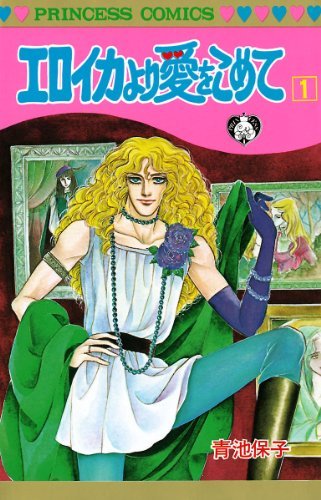
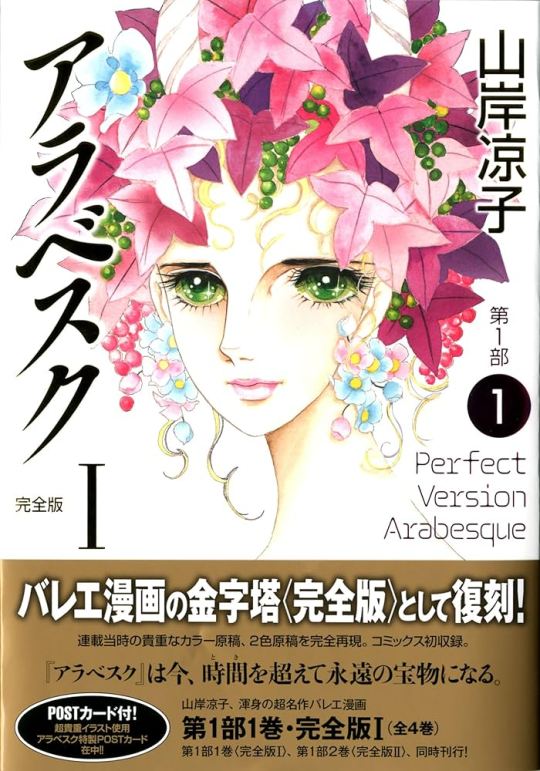
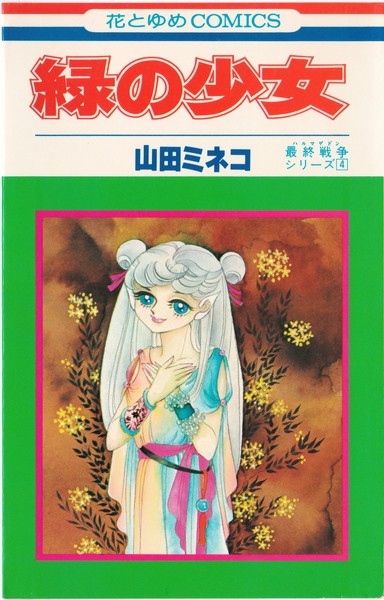

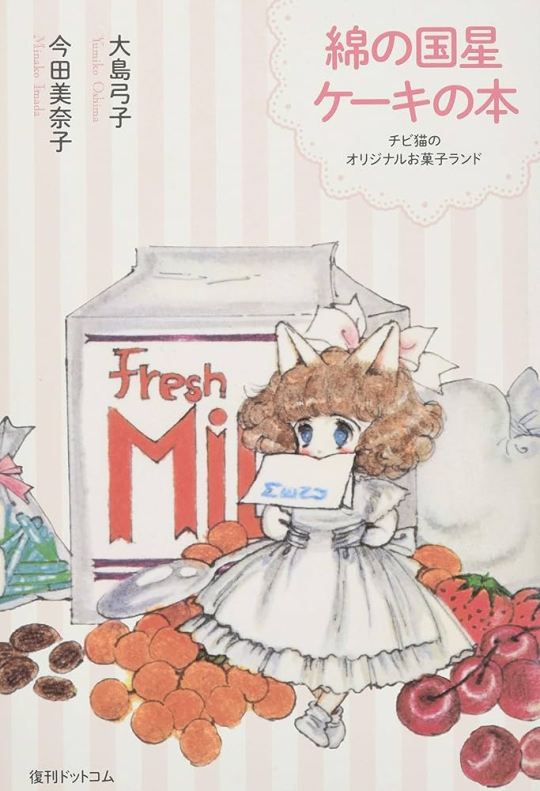

Some of the best-selling work by the Year 24 Artists (l-to-r): Yasuko Aoike's "From Eroica with Love," Ryoko Yamagishi's "Arabesque," Mineko Yamada's "Minori no Shoujo," Toshie Kihara's "Yomie no Ishibume," Yumiko Oshima's "The Star of Cottonland," Yuuko Kishi's "Tamasaburo."
Back in the early '70s, there was the prevailing notion that manga was for young kids. Despite the variety in themes, big magazines like Margaret, Shoujo Club, Nakayoshi, and Ribon were theoretically aimed at elementary school-aged girls.
In practice, the reality was more nuanced. Due to being published in Weekly Margaret, "The Rose of Versailles" was for kids. And it did very well with them. Yet, its revolutionary romance also appealed to broader audiences, exemplifying the crossover potential of shoujo manga. It was the title that opened the door for what is known as "the golden age of shoujo," which was further cemented by several other groundbreaking hits.
These hits widened the shoujo manga field, and soon, other editorial houses also wanted to cash in. Shogakukan, which published the powerful Weekly Shonen Sunday, entered the shoujo market in the late '60s. Shueisha and Shogakukan also partnered to form a keiretsu and open the Hakusensha publisher which deals mostly with shoujo manga.
That is the context in which a batch of artists known as "The Magnificent 24 Group" rose. And they were another key reason as to why '70s shoujo made such a mark. These manga-kas introduced themes such as sci-fi and homosexuality to the segment, revolutionized its art, further explored historical and terror narratives, and generally broke barriers of what was possible in shoujo manga. Their work was intellectually challenging, philosophical, and, above all, fundamental for male manga critics and connoisseurs to finally take shoujo seriously.
The Year 24 Group refers to the fact most artists were born around 1949, which is known as the year 24 of the Showa era in the Japanese calendar. These women came of age during the time artists like Hideko Mizuno were debuting and doing revolutionary work in the shoujo field, and they were eager to follow their lead. The success of unorthodox hits like "The Rose of Versailles" and the emergence of new magazines enabled them to be bold.
The two artists who led the movement are Moto Hagio and Keiko Takemiya. Their shared house in Tokyo, known as the Oizumi Salon, became a gathering place for several young artists keen on breaking new grounds for shoujo manga-kas. These women became the Year 24 group. But there were other two people, besides the artists themselves, who were just as crucial for the existence of the movement.
Firstly, there was Junya Yamamoto. Yamamoto was a young male editor at Shogakukan who had risen through the ranks of the successful Shonen Sunday weekly manga magazine. Noticing they were lagging behind Shueisha and Kodansha in the manga segment for their lack of a robust shoujo presence, the editorial house appointed Yamamoto to launch Shoujo Comic (known as Sho-Comi) in 1968 and Bessatsu Shoujo Comic (known as Betsucomi) in 1970. However, he quickly ran into an issue: most successful shoujo artists already had exclusive contracts with the competing houses, and aspiring names were vying for positions at the already established magazines.
In 1969, the "God of manga," Osamu Tezuka, introduced Yamamoto to Keiko Takemiya, then a university student living in Tokushima City. Takemiya had spent her school years dreaming of becoming a manga-ka and participated extensively in the readers' corner section of COM. COM was an avant-garde manga magazine Tezuka founded to nourish young talents and publish stories without the typical restraints of more commercial shoujo and shonen publications. In her first year of college, Takemiya won a Shueisha's Weekly Margaret newcomer competition and had a work published in the magazine. Still, she was persuaded by her parents to focus on her studies instead and to leave manga as a side hobby.
Yamamoto, in turn, was impressed with her talent and convinced her to chase her dreams. Quickly, she found work in all three publishers and started simultaneously publishing in Kodansha, Shueisha, and Shogakukan's shoujo titles.
Meanwhile, Moto Hagio also grew up enamored with the manga world. During her college years, she had a work selected by Shueisha's Bessatsu Margaret (Betsuma) through a competition, but she could not find a fixed slot in the magazine. Then, she got introduced to Kodansha's Nakayoshi editors, who were impressed by her talent. While she did start publishing short stories there, editors rejected most of her submitted work as they did not fit the magazine's mold. One day, an editor introduced her to Takemiya, who, overworked while working for several magazines, was in dire need of an assistant. The two hit off, and Takemiya, who until then had her permanent residence in far away Tokuma City but was planning a move to Tokyo, proposed they both live together. She also decided to introduce Hagio to risk-taker editor Yamamoto, who, impressed by her talent, encouraged her to pursue her path instead of trying to fit into the expected shoujo template.
Then there was Norie Masuyama, who first became acquainted with Moto Hagio before becoming Takemiya's manager. Hagio was from Fukuoka, while Masuyama was from Tokyo, but due to their similar interests, they became penpals. When Hagio first moved to Tokyo, Masuyama hosted her in her home in Oizumi. Eventually, Hagio introduced Masuyama to Takemiya, and the three of them became close. Because both were artists from outside of Tokyo, Masuyama suggested Keiko and Moto should live together, and she was the one who alerted them of a house in her Oizumi neighborhood being up for rent.
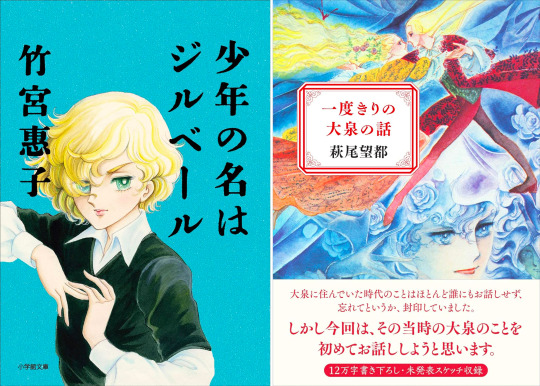
Keiko Takemiya and Moto Hagio, estranged since the late '70s, revealed details of their feud in autobiographic books: Takemiya's "Shonen no na wa Gilbert" (2019) and Hagio's "Ichidou kiri no Oizumi no Hanashi" (2021). The dispute, stemming from Takemiya accusing Hagio of plagiarism, was fueled by Takemiya's jealousy during a challenging creative and personal period. While Takemiya appears self-aware and analytical in her account, Hagio's book indicates she hasn't forgiven Keiko, revealing unresolved feelings. The publications triggered intense online debates.
Masuyama came from a sophisticated family that was very involved in arts and, from a young age, got familiarized with the world of music, literature, and movies. Her refined taste impressed Hagio and Takemiya. At a time when Japanese girls dreamed of Europe, Masuyama actually had friends living there and was up-to-date on the latest European trends. She also had a lot of knowledge of European cinema and literature.
As their rented house was old and rusty, Hagio and Takemiya started spending a lot of time at Masuayama's house across the street. She introduced them to films, songs, books, and paintings. It was Masuyama's taste -- including her interest in movies and books depicting gay romance and her desire for girls' comics to have bolder and riskier themes -- that helped to instill a passion in both artists to go further than the safe cliches usually depicted in shoujo works.
In 1970, editor Yamamoto convinced Takemiya to sign an exclusive contract with Shogakukan. The following year, Hagio also started publishing for Sho-comi and Betsucomi. Their work would attract a loyal fanbase, and aspiring manga-ka would flood their mailboxes. So Takemiya made a decision: to select female artists around her and Hagio's age to mentor and train at their shared home. Thus, the Oizumi Salon was born.
Despite attracting attention, Takemiya and Hagio's works were not always popular. In fact, they'd often rank last in readers' popularity polls, which tend to be all-deciding in manga magazines. But they persevered, and Yamamoto trusted them.

Keiko Takemiya aimed to establish herself with a top-rated series through "Pharaoh no Haka" (left) in order to garner the necessary respect from editors to write the series she wanted, "Kaze to ki no uta" (right). Despite her resolute efforts, "Pharaoh no Haka" never secured the top spot in Sho-comi's readers' poll, peaking at #2. Nevertheless, the series succeeded in elevating her fame and earning her the respect she sought.
In 1972, Hagio had an idea for a serial focused on a male European vampire. However, as she wasn't a famous artist, Yamamoto only allowed her to publish one-shots. So she came up with a plan: to write three interconnected standalone stories. To circumvent another restraint - shoujo editors' avoidance of male leads - she put the first story focus on Marybelle, Edgar's sister. Once Yamamoto realized what Hagio was doing, he was amused and allowed her to continue. And so, "The Poe Clan" series began. In 1974, Shogakukan finally started publishing their shoujo titles in compiled paperback format. In another proof of trust, Yamamoto chose Hagio's "The Poe Clan" as the first title of the Flower Comics imprint.
To everybody's surprise, "The Poe's Clan," in paperback format, was a groundbreaking success, almost instantaneously selling out its initial printing. At the time, Hagio had just started a new serialization, "The Heart of Thomas," a tragic gay love story set in an all-boys German school. As usual for her, the story wasn't all that popular with Sho-Comi's readership, and its lackluster results in the reader's poll almost got the series discontinued. But the notable success of "The Poe's Clan" tankobon assured editors, who allowed Hagio to continue the series. "The Heart of Thomas" went on to become another best-seller and a seminal shoujo title. It also attracted critical acclaim and a loyal fanbase to Moto Hagio, which in turn helped put the Year 24 artists -- who were pretty good at self-promotion -- in the spotlight.
Hagio, Takemiya, and several other "Year 24" authors drifted between being popular and underground. They had a sizable, loyal fanbase that followed them and turned several of their works into best-sellers. On the other hand, by finding a way around the usual shoujo traditions, they weren't particularly popular with the average shoujo reader, ordinary young girls across the country.
Their peculiar position forced them to be clever, so they could fulfill their creative desires as well as their editors' expectations, who were there to make sure the stories published were satisfying to the core readership. Takemiya wrote "Pharaoh no Haka," an Egypt-set romantic adventure, to be well-accepted so that she could then dedicate herself to doing what she truly wanted in "Kaze to Ki no Uta," a gay love story set in a 19th Century French boarding school.
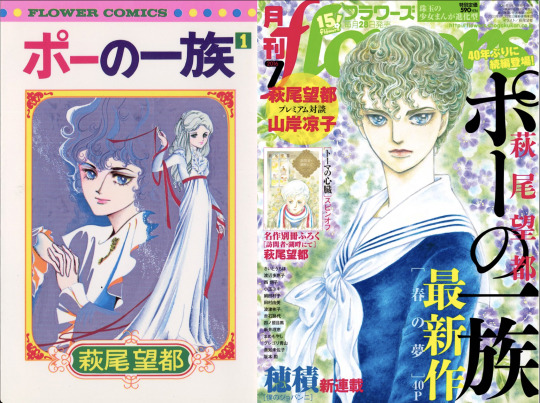
Initially overlooked in popular shoujo magazines, Moto Hagio gained success with "The Poe Clan" in compiled format, launching Shogakukan's Flower Comics imprint. Over time, she became a highly respected manga artist, the only manga-ka alongside legendary filmmaker Hayao Miyazaki to receive a Person of Cultural Merit recognition. In 2016, marking 40 years of the conclusion of her first hit, she released a new "The Poe Clan" chapter in Flower magazine, selling out the increased print run of 50,000 copies in a day. This success marked a significant shift for Hagio, who, despite not being a major magazine seller in earlier years, became a valuable asset to the struggling publishing industry. Following the one-shot, she released three more chapters and, in 2022, began a new sequel series.
Besides Takemiya and Hagio, several other notable shoujo artists who went on to become huge names used to frequent the Oizumi Salon and were part of the "Year 24 group." In the early '70s, most published their work on Shogakukan's titles, which had a "free policy" on storytelling compared to Margaret, Shoujo Friend, Nakayoshi, and Ribon. Then, as Shogakukan started being more strict to properly compete with the market leaders, several moved to newly launched Hakusensha titles Hana to Yume and LaLa. Influential names that were part of the movement included Yumiko Oshima, Yasuko Aoike, and Ryoko Yamagashi, among several others.
Despite their unorthodox preferences, they weren't necessarily trying to rebel against the system, they simply wanted to put out good quality work they believed in. Like other Japanese girls from that era, they were fascinated by Europe, and plenty of their stories took place on the continent. In 1972, Hagio, Takemiya, Yamagishi, and Masuyama made a 45-day trip to Europe, visiting the Soviet Republic, France, and several other countries, which had a profound impact on them. Still, their narratives were widely innovative. They often had male leads, introduced sci-fi, "boys' love," and other bolder genres to shoujo manga, and contributed to the evolution of shoujo illustration. Above all, this group of artists was the one who made clear to naysayers, once and for all, that shoujo manga is indeed an art form.
But while their influence in manga history is undisputed, other significant -- and much more commercial -- manga movements also shook the shoujo manga world during that decade.
A Need for Drama
When talking about '70s shoujo manga, it's common for minds to drift directly to iconic series from that time, like "Candy Candy" and "Rose of Versailles." But, unlike in present times, in that decade, the manga industry's focus wasn't on successful, long-running series but on the artists themselves.
As opposed to the struggling publishing marketing of today, major shoujo manga magazines all sold over 1 million copies during that decade. Manga in tankobon (standalone paperback) format was turning into a money-maker field, but being able to sell paperback was very much secondary compared to being a name capable of selling magazines. Keiko Takemiya and Moto Hagio, from the Amazing Year 24 Group, would go on to become household names and had best-selling series, but, at the time, they couldn't compete with the actual shoujo manga superstars who were the signboard artists of the Kodansha and Shueisha's shoujo titles, the ones who actually moved publications. These artists' work was the most significant indicator of what the mainstream readers wanted and aspired to back then.
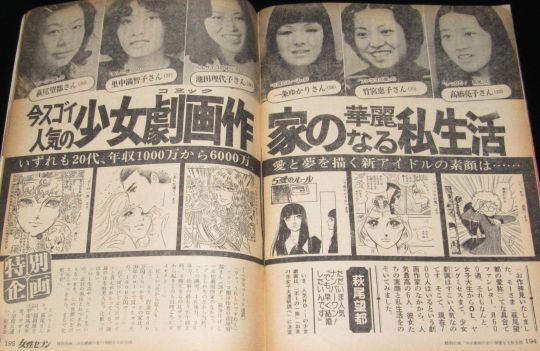
In a December/1975 issue, weekly Josei Seven spotlights the new generation of superstar shoujo manga artists: (l-to-r) Moto Hagio, Machiko Satonaka, Ryoko Ikeda, Yukari Ichijo, Keiko Takemiya, and Ryoko Takahashi. While contemporary manga-kas are highly discreet about their lives and do not even tend to show their faces, in the '70s, they were treated like superstars, and, in the article, the manga-kas openly discuss their love life and details of their high incomes, including how much they had in the bank and how much they spent on rent and daily utilities.
For Kodansha, the top shoujo artist was definitely Machiko Satonaka, who won the Best New Artist competition in 1964, when she was still a freshman in high school. There have been several high-schoolers making their debut in the industry throughout the decades, but, as the first, Satonaka caused a media frenzy. Her ascent gave confidence to countless other young women -- from "Glass Mask"'s Suzue Michi to Keiko Takemiya (who also won a smaller prize in the same competition) -- to pursue their manga careers.
The attention surrounding Satonaka, who went on to become a public personality with TV hosting gigs and other appearances, is another interesting, nostalgic phenomenon. In the past, it was common for manga superstars to have a strong media presence. Nowadays, the norm is the complete opposite: for manga-kas to be highly private, no matter how famous their work is.
In any case, Satonaka quickly proved herself to be more than a sensational news story as she created extremely popular mangas for Kodansha shoujo titles like Shoujo Friend and Nakayoshi. Her style, widely accepted by readers, became symbolical of the story-telling the '70s girls craved: extremely dramatic with emotionally driven plots and lots of bombastic twists and developments.
In his book on subcultures and otaku culture, sociologist Shinji Miyadai notes that '70s shoujo manga can be divided into very few categories. There is the category the Year 24 artists dominated -- which he defines as the "Moto Hagio domain" -- of works with a lot of artistic value, up-to-par with literature. And then there's the far more commercially viable "Satonaka domain," which represented the mainstream taste.
In the "Satonaka category," the artist depicts a stormy life story as a proxy experience for the readers. Of course, there are universal elements of love, friendship, and insecurity that girls can directly relate to. Still, these stories provide adventures that readers could never experience in the real world.
These facets of the "Satonaka domain" are present in almost all the best-selling, mainstream shoujo series of the '70s, like the revolutionary historical romance of "The Rose of Versailles," the dramatic rags-to-riches story of the beautiful orphan in "Candy Candy," and the rise of an ordinary girl to the top of the sports elite in "Ace wo Nerae." In all of these titles, you'll also spot other defining characteristics of '70s shoujo: the death of beloved characters and beloved female characters with voluminous blonde hairs and huge, sparkling eyes (a legacy of Macoto Takahashi, the illustrator who, throughout the '50s, created the art that directly influenced subsequent shoujo history).
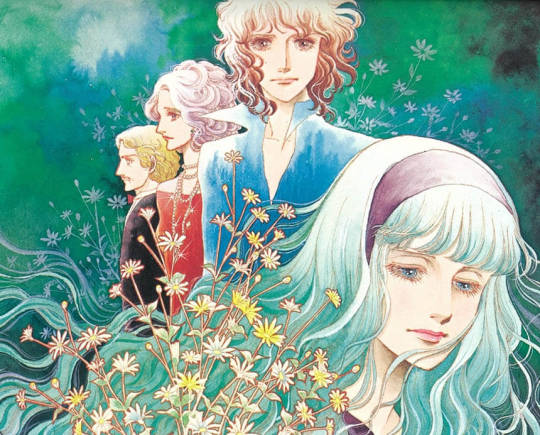
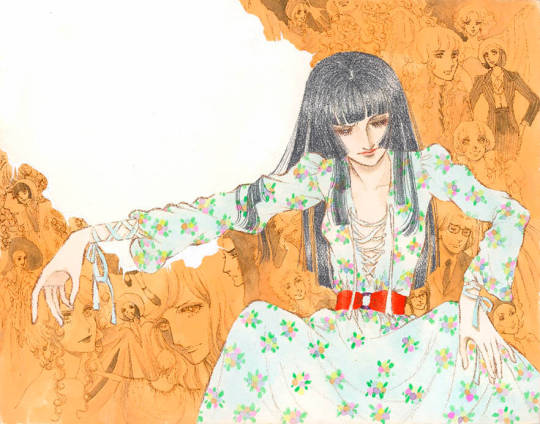
Yukari Ichijo was the most prominent Ribon signboard artist throughout the '70s, creating popular mangas like "Suna no Shiro" (left) and "Designer (right). Young girls across the country adored her work despite the adult drama in it.
Since these stories are extraordinary and dream-like, many of them use Europe or the US as their setting, another reflection of the times when Japanese youth dreamed with the West.
While Satonaka was Kodansha's star, Shueisha also had its top shoujo artists. For Margaret, it was Ryoko Ikeda who kept creating memorable dramatic manga after the conclusion of "The Rose of Versailles." Other classic '70s dramatic works published in the weekly included Kyoko Ariyoshi's ballet drama "Swan." Meanwhile, over at Ribon, no one shone brighter than Yukari Ichijo. Ichijo's works, which young girls across Japan devoured, contained a lot of adult drama with adult characters. Her 1974 manga, "Love Game," had a bed scene. One of her most celebrated works of the decade, "Suna no Shiro" (Sand Castle), dealt with incest. While Ichijo is the one who stood the test of time, another artist who also enjoyed great popularity in Ribon following this formula was Kei Nogami.
These mangas served as an escape for girls, who left their ordinary school life behind for a few hours to embark on extraordinary adventures. In contrast, one of the main genres in contemporary shoujo is unassuming, everyday high school romance. How could the shoujo segment go through such a drastic transformation? The reasons for that also dates back to the 1970s.
Part 3
#shoujo manga#vintage shoujo#otometique#yumiko oshima#keiko takemiya#yumiko tabuchi#hideko tachikake#machiko satonaka#yukari ichijo#ribon#1970s japan#1970s#year 24 group#moto hagio#vintage manga
38 notes
·
View notes
Text
Women artists in Napoleonic France

(Young women copying: ‘Love begging Venus to forgive Psyche’ which was displayed at the 1808 Salon. Sketch by Georges Rouget)
Quotes from an article about women’s participation in the art world during the Napoleonic era.
Article:
Heather Belnap Jensen, “The Journal des Dames et des Modes: Fashioning Women in the Arts, c. 1800-1815,” Nineteenth-Century Art Worldwide 5, no. 1 (Spring 2006) (source)
“More and more women artists began exhibiting their work in public venues and receiving recognition for their contributions at this time. While only three women artists had participated in the 1789 biennial Salon, fifty participated in the Salon of 1806–an increase in women’s participation of over 1600 percent in seventeen years.”
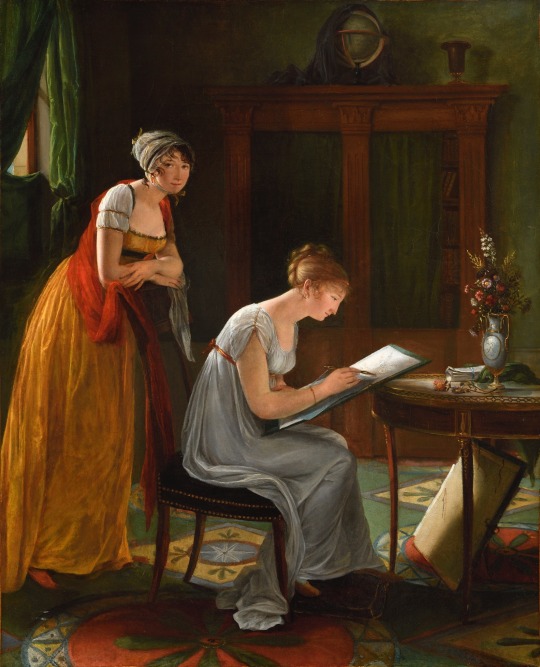
(Woman artist giving a drawing lesson — Self-portrait, 1810, by Louise-Adéone Drölling)
“We see a move away from the emphasis on the public sphere to the private space as motifs, intimating a valorization of a woman’s world. While history painting, which played such a crucial role in Revolutionary visual culture, remained the privileged genre at the turn of the century, the rise in portraiture, landscape, and genre painting in Napoleonic France indicates this shift in values.”
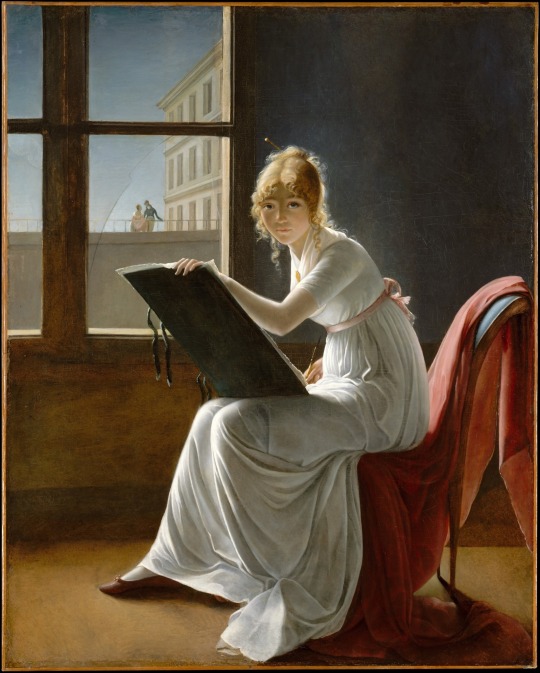
(Young Woman Drawing—Portrait of Charlotte du Val d'Ognes, 1801, by Marie-Denise Villers)
“Women’s journals, which often published art-related materials, have been largely overlooked in discussions of developments in late eighteenth-and early nineteenth-century French visual culture. This is surprising, given that bibliographies on art criticism of this period frequently cite items from these publications.”
One of the most influential women’s journal of the period was Journal des Dames et des Modes. It was created by Jean-Baptiste Sellèque and Pierre de La Mésangère in 1797 and continued until 1839.
“La Mésangère’s key collaborator during the Napoleonic period was a woman, Albertine Clément, née Hémery, a well-known figure in both journalistic and cultural circles in post-Revolutionary France, and that several women were regular contributors to this journal during this era.”
Annemarie Kleinert did a study on the journal:
“She determined that the journal targeted bourgeois women between the ages of 18 and 40 years old who could afford the annual subscription rate of 10 livres, and that the majority of subscribers during the period from 1800 to 1815 were from the provinces.”

(Portrait of a Young Woman Drawing Herself, early 1800s, by Louis-Léopold Boilly)
Interest from women in creating their own designs:
“Fashion plates that accompanied each issue of this journal gave visual testimony to this heightened interest in women’s artistic engagement. Indeed, women in fashion plates were sometimes presented in the act of sketching and drawing, as shown in a plate that appeared as an insert in an 1802 issue of the Journal des Dames et des Modes.”
The act of women creating art was compared to motherhood. In that way, women were encouraged to make art, but in terms which enforced traditional and patriarchal ideas:
“Furthermore, the vocabulary used by the author stresses the ways in which artistic creativity mirrors childbirth and elicits feelings of exaltation over one’s art that are similar to those evoked by motherhood when he writes that ‘she smiles at the objects which are born of her colors’ and calls the site of her production a ‘creative space.’”
There were opportunities for women to paint nude subjects for classical style art:
“Recent scholarship suggests that there were opportunities for such study in the Napoleonic era. By 1800, female students could attend anatomy classes given by the surgeon Sue and also by the École du Modèle Vivant at Versailles, and artist Adele Romilly reported that David, Régnault, and Guérin all provided mixed studios that offered courses on life drawing from the nude.”
One of the claims made against the women’s journals is that they were sexist. The author points out that it’s more complicated and not entirely true. The journals included laudatory reviews of paintings by female artists at the salons, biographies of women artists, such as Angelica Kauffmann, and published excerpts of pamphlets written by women, such as Angélique Mongez.
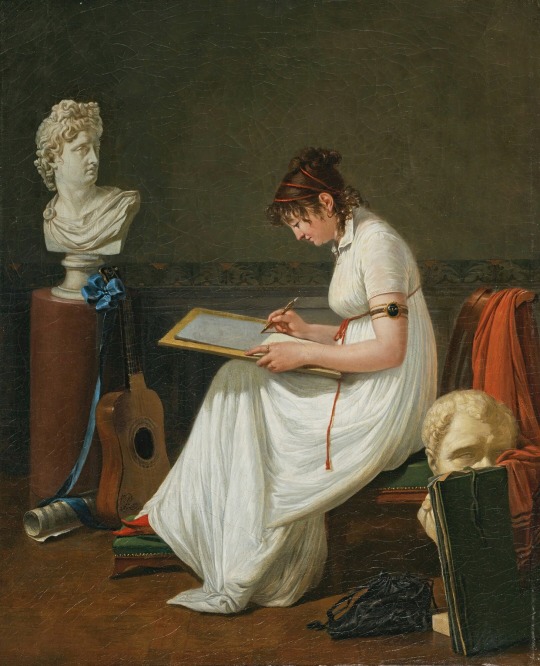
(Portrait of an Artist Drawing after the Antique, c. 1800s, Jean François Sablet)
However, the author also says there was a lot of anxiety about the increase in female participation in the art world, both as creators and as spectators. There were articles describing women at museums in derogatory terms. One in particular described a young girl being overcome by emotion at the sight of the statue of Apollo Belvedere and creating such a large scene that she had to be dragged away in tears.
These articles imply that women spectators had become dominant enough that it could inspire critics.
Women had become so important in the art world that a really unique phenomenon happened:
“Roger Bellet has demonstrated that there are known instances in late eighteenth-and early nineteenth-century France when men published under a female pseudonym.”
Many of the top artists who were admired in the era were women such as Élisabeth Louise Vigée-Lebrun, Marguerite Gérard, Constance Mayer, Adèle Romany, Adélaïde Labille-Guiard, Pauline Auzou, Jeanne-Elisabeth Chaudet, Marie-Guillemine Benoist, Constance Marie Charpentier and many others.
#art#women’s art#women artists#napoleonic era#napoleonic#mine#fashion#writing#first french empire#napoleon bonaparte#quotes#ref#reference#Journal des Dames et des Modes#19th century#1800s#fashion history#historical fashion#history of fashion#french empire#france#history#french revolution#frev#women’s history#womens art#women in art#women painters#fashion plates
61 notes
·
View notes
Text
When it comes to transmasc representation in old media no one fits better than Oscar François de Jarjayes from "The Rose of Versailles" (1979) (Lady Oscar for my Italian friends). So much so that at some point I thought of having Oscar as my second name.
He's a fictional character set in a story based off of real-life Marie Antoniette as a teenager.
He's raised as a boy because he's the youngest of six, and never actually goes "back" to being a woman, because he dies fighting during the French revolution.
Oscar’s identity is a cause of great conflict in the manga and the anime. His agency is constantly taken into question, everyone around him is convinced he’s being forced to be a man by his father, when he’s constantly rejecting womanhood.
Transgender Identity as Parental Abuse, And Oscar's Agency
It's important to mention that Oscar is almost always referred to as a woman. The people close to him know he’s not cisgender, and always refer to him as a lady. But people who have never met before assume he’s a boy.
He's always told to be more feminine by those around him except, most of the time, by his father. His father's decision to raise him as a boy is actually portrayed as dramatic, with thunder and lightning.
His friend André calls him Oscar while André’s grandma scolds him, telling him to call him Milady Oscar because of his lower rank as a servant.
And even as Oscar tells her he likes it better this way, André’s grandma brushes her hand on a dress, reminiscing that Oscar could be wearing that instead of his boy clothes, and that she hopes one day he'll attend a ball dressed as a beautiful lady.
Later she drunkenly moans: "Oh poor Oscar, there's a conflict inside of [him], [he] doesn't know whether to be a man or a woman!"
Throughout most of the show, actually, people think Oscar acts like a boy because it's his father's wish, when it's Oscar himself deciding to present as a boy.
Oscar's agency is always questioned, just like it is for transmasc people and trans men (as well as the vague entity known as “the children”), supposedly "brainwashed" young girls. Many transphobes actually think trans kids are forced to transition because of their parents.
The recent decision in Texas to investiagte and remove transgender children from their families on the basis of “child abuse” echoes this sentiment, for example.
In the very first episode, André tells him "It's not too late! Become a woman, Oscar!" as he runs away. And even though he hated the prospect of becoming the Captain of the Guards, he chooses that over becoming a woman.
The narrator even says "And so Oscar chose to become a man."
He's running away from his assigned role at birth by doing something he hates. He could have chosen to stay and "become" a woman, like Andrè and his grandma say, but he doesn't want to.
As his first assignment as captain, he’s ordered to dress as Marie Antoniette to take her place during a planned kidnapping, and he reacts by throwing away the dress and walking away angrily. His father actually sees his manhood as a costume he can take off whenever it’s necessary, Oscar sees it as his identity.
And even after Oscar's father decides to marry him off, he still doesn't want to play the role of a woman. But nothing seems to convince people that he's acting of his own accord.
Alternatively, many characters treat him like a silly girl who’s just playing pretend. It’s true that Oscar is young, but his identity in manhood is just as strong as those of the men around him.
Detransition Because of Social Pressure
Oscar doesn't express any wish of wanting to be a woman, except once when he dresses as a woman hoping to make a man fall in love with him, but learns the man is already in love with Marie Antoinette and desists.
Marie Antoinette also feels attracted to him, even though she says she’s disappointed Oscar was born a girl.
Which I think is very relatable for a transmasc person, to feel like we're unlovable as we are. Oscar trying to fit in his "womanly role" (the one time in the entire show) isn't really out of place, it's reminiscent of transmascs and trans men detransitioning because we're not accepted by the people around us.
Andrè, confesses to being in love with him (when he's seen him in nothing but men's clothes his whole life, might I add. He's not attracted to Lady Oscar, he loves Oscar the Captain of the Royal Guards.) but Oscar pushes him away and joins the army instead.
Transgender Identity Seen as Childish
At this point, his father regrets letting Oscar be "too unfeminine" and plans to marry him off.
This, to me, is another aspect of being trans even in a supposedly accepting family. There's an age threshold at which it's not acceptable to be trans anymore, that it's something childish that eventually the teenager will forget and join in their role in society. Then there’s the entitlement that families feel they have over children.
Yet another man, his rival, asks for his hand, but Oscar refuses. Then, as a Commander in the Army, he affirms his leadership on his troop, making yet another man, André’s friend this time, fall in love with him.
Most of these men have seen Oscar appear exclusively as a man. All of them, to my knowledge, are aware that Oscar isn't a cisgender man, but Oscar never presents as a woman, and he still manages to make three men fall in love with him.
Oscar realizes that he's in love with Andrè as well, and switches to fighting against the Monarchy with him, but dies by his side during the Storm of the Bastille.
The Return of Oscar
In a completely non-canonical book that only came out in Italy, Oscar doesn't die and instead becomes the Black Knight (a character that appears in the original manga), fighting against injustice.
It's revealed that he didn't die, instead just lost his memory. Once he regains it, he moves to England and lives a quiet life as Rose.
But that doesn't last, and he goes back to France to become the Black Knight. This is, in my opinion, just another instance of detransition that doesn't last (it's non-canonical as well). After all, Oscar is alone in England, the people that previously supported his masculinity are dead or have disavowed him, like his father.
He also kisses Napoleon. This man can't stop making men fall in love with him.
The story ends with Oscar leaving for America, but all of this is not canonical anyways.
In conclusion, Oscar's identity in manhood is constantly questioned or completely disregarded. Even as he says "My duty as a soldier comes before being a woman" everyone assumes he's simply being edgy.
Oscar is born to be a soldier and dies as a soldier. But being a soldier isn't even something he wanted to be in the first place. He just took on the role to avoid becoming a woman, both in the sense of getting married and starting a family, and in the sense of being seen as a woman.
Really, Oscar uses "soldier" as a short-hand for "man."
348 notes
·
View notes
Text
back back back again with the lafayette content (lafayette pt. 5)
you know the drill, here's pt. 4, gay people
Where we left off, Lafayette had just had a very exciting campaign in Rhode Island (the most exciting thing to ever happen in Rhode Island), but now what? Nothing. Nothing is happening. I'm not joking, he was bored for several months.
So, here's the real question, how would you, as a little French man in America who somehow obtained the title of major general, handle your boredom? Correct! You would duel Lord Carlisle, the head of the British peace commission.
Or at least, you'd try. Lafayette challenged Carlisle, but Carlisle fucking ignored him. Because obviously.
So when that fell through, Lafayette decided to just. go home. Not permanently, but for a visit. I mean, he was only gone for like a shit ton of time, and had left behind his pregnant wife without a real explanation, and in that time his eldest daughter, Henriette, had DIED. So, it was about time to go home. And when he was contemplating this, he checked how much money he had left, and realized he was broke and was like yeah it's time to go home.
In addition to this, he also wanted to apologize to the king since he kinda fled the country against direct orders and nearly started a war with England. One of Lafayette's main goals in life was to fight under the French flag, and he couldn't really do that unless the king liked him. So, he got a letter of recommendation and the promise of a ceremonial sword from Benjamin Franklin, and headed home to France.
Back, back, back again (in France)
Everyone was SO HAPPY to see Lafayette in France, and I would be too. Lafayette went to Versailles and was like "heeyyy King Louis XVI, my favorite king of all time, I'm really sorry for fleeing the country despite direct orders not to and nearly starting a war with England, do you forgive me?" and King Louis XVI put him on house arrest. But, to be fair, that is a very mild punishment, considering what he did was somewhat akin to treason.
Also, fun fact for the frev/Marie Antoinette girlies who know about her relationship with Lafayette during the French Revolution, she actually intervened on his behalf, which allowed him to buy a command of a regiment of the King's Dragoons! Which is like a huge favor because that command cost him 80,000 livres, which in modern US dollars is what the scholars call a shit ton.
This new popularity in France allowed him to aid the American cause in France by corresponding with French and American dignitaries, advocating the wants and needs of one side to the other. He actually played a vital role in this area, and John Adams, who did absolutely fuck all, got jealous and started beef with him for no fucking reason.
Lafayette didn't forget about his military ambitions, and was apart of a plan to attack the English mainland with John Paul Jones. This didn't work out and Lafayette was greatly disappointed (again), but it would never have been supported by France, so idrk what they expected. Fun fact, this was one of the many ideas Benjamin Franklin and Lafayette came up with together, along with a kinda gruesome children's book.
In the meantime, Lafayette daydreamed about being sent back to America in charge of the French naval forces he helped to negotiate. As you expected, he was very disappointed when they were put under the command of Rochambeau, who was just overall more qualified for the job.
While he was in France, he engaged in some ~aristocratic adventures in the arts and sciences~, and that's not an innuendo, he almost joined Franz Mezmer's cult. This is, actually, the first of two times he almost JOINED A FUCKING CULT. The second time was an Amish cult. So. There's that.
(If necessary, I can employ my boyfriend to explain how Lafayette was exactly the kind of person to get roped into a cult.)
In America Again! (This time it's Serious)
Lafayette returned in a bleak season of the war in which many of the Continental officers (Washington included) were itching for a major engagement with the British, and planned a French-American attack at some large British occupied area, hopefully with a good port.
The ideal place seemed to be New York City, and Lafayette was fixated on that. He was hoping he could have a major command in the attack. And, you guessed it, was super disappointed when he was ordered to march to Virginia to join General Greene. He was present for most of the Virginia campaign, and his main target was the traitor, Benedict Arnold.
PLOT TWIST that major attack was never in New York, but would actually be at Cornwallis' station in Yorktown, Virginia. Lafayette commanded the major Continental infantry forces that kept Cornwallis pinned at Yorktown while the commands under Washington, Rochambeau, and Admiral de Grasse surrounded him in a violent siege.
The one catch-up was that the trenches they were digging couldn't fully surround the British reinforcements due to two redoubts, 9 and 10. Lafayette's American command (led by Colonel Alexander Hamilton with his own command and Colonel John Laurens with a division under Greene) partnered with a division under Rochambeau to attack the redoubts, which led the British to surrender.
One of my favorite little details about the Revolution is that, at the surrender, the British troops refused to look at the American soldiers, so Lafayette told his band to start blasting Yankee Doodle to get their attention. Absolute icon.
I'm gonna cut this one a little early since this is the end of Lafayette's involvement in the American Revolution, and the French Revolution will require WAAYYY more attention. See you in part 6, gay people
#lafayette#marquis de lafayette#alexander hamilton#john laurens#history#amrev#george washington#american history#amrev history#american revolution#do it for richie 💪
32 notes
·
View notes
Text
Asumi Rio Rose of Versailles 50th Anniversary Interview
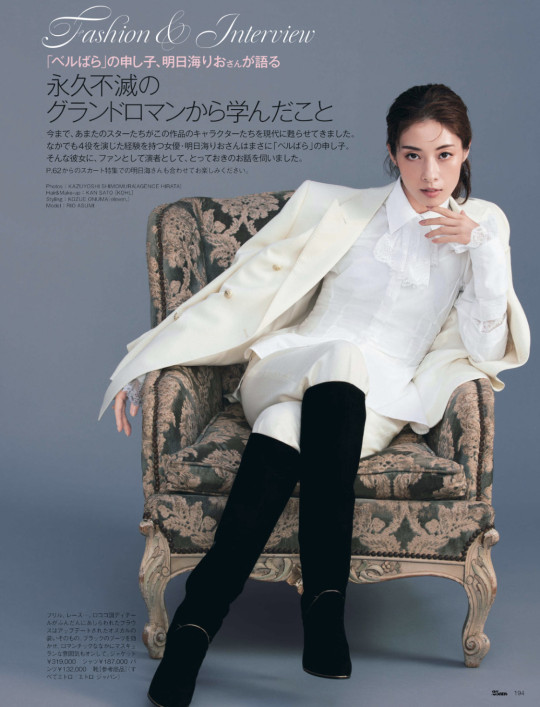

The Berubara heaven-sent child, Asumi Rio speaks
(translation on 11/07/22)
From 25ans October 2022
interview below the cut
Asumi appeared inside the studio with an otherworldly, pure beauty, as if an angel had descended onto this world. However, as soon as she changed into an all-white Etro look, there was a sudden transformation into a dignified appearance much like that of Oscar-sama, then in a blink of an eye, another switch occurred, and all the staff with no words prostrated themselves before her.
Asumi, was your first Berubara the manga? Or was it the Takarazuka staging?
“For some reason, the manga was in my elementary school’s library. When I read it, my impression was first and foremost, Ikeda Riyoko’s amazing art; full of dresses, roses, and military uniforms, it's packed with every girl’s dream. I thought it was so amazing.”
So it was a fateful meeting in elementary school! Berubara has many charming characters that appear inside of it, but who are you most attracted to?
“I like Andre. Isn’t he the best? Always full of love quietly watching over this singular girl, it’s so lovely. In the end, despite losing one of his eyes, he still charges into war with Oscar, it was just... (Overcome with emotion). As for another role I have played, Oscar and I have quite different personalities, she’s thinking of her city and France, always questioning if her actions are right or wrong. She lives at a fast pace. She’s compassionate, devoted to her sense of righteousness, and more gallant than any man. Furthermore, she has both that of a maiden’s mind and a masculine firmness to her, playing her requires a lot of energy. In the passionate love story that is Fersen and Marie Antoinette, I played Fersen whose feelings towards the Queen lay right at the center. During these events, Marie knew of Louis the 16th’s love, as well as nurturing a love for her children, on one hand, she had grown as a queen throughout this, but even when she resolved to enter the guillotine, Fersen had come and said to her, “I have come to pick up your Majesty,” this showed how he fundamentally had not changed. An unrelenting perfectionist, archetypal lover boy who's filled with an unchanging passion, he was a role that had a high hurdle to jump over to play him stylishly. Another role, Bernard, after having played both Oscar and Andre, this allowed me to play with a deepened understanding of the city and the guard, so it was really fun.”

What was the most impactful moment?
“In The Rose of Versailles, the lighting, the sound effects, the gazes, the script, all the cogs work together perfectly, it's like it's all a single work of art. That’s why picking just one is hard, but if I have to choose, the Bastille. But it's hard to just ignore that scene with Marie and Fersen in the prison. In the Bastille, when Oscar charged into war after Andre died, that intense choreography with the subtle nuances and emotions that the choreographer taught us, really was created with everyone in mind. Oscar was struck! ‘Are you no longer here?!’ ‘Are you surrendering?!’ (Asumi doing a reenactment alone...) Oh gosh, I'm going to cry. There's no room for error in the production, all the drama of characters appearing concentrated in that scene, it still gives me goosebumps. As for songs, I like Andre’s “Shirobara no Hito”! Asakaze ni♪ (Asumi who starts singing). For finale numbers, I like the rockette. (While singing the French national anthem) Tatata tan tan tan taan! And then instantly the lights flash on and everything lights up all glamorously. As for something I appeared in, the bolero duet, simply because it’s simple is what made it difficult, so I remember it vividly.”

Remaining immortal from now and forever on, the fruit of love from the creator and performers.
Actually standing on that stage, did you end up experiencing any hardships?
“Maybe the ‘Kata* (forms)’? When I starred in the Rose of Versailles, I was incredibly lucky to have Haruna Yuri come and provide some acting guidance. She taught us every single move. At the start, precisely because we had always done more natural acting, jumping into ‘kata’ was extremely difficult, but that said form worked with the time period’s landscape and music, the set, and the scale of it all matched the scale of emotions. When this all came together, it became something I would really look forward to seeing. My mood would really improve, naturally being able to move into that ‘kata.’ Natural acting wasn’t enough for this. Not until overcoming this did I understand adding this little extra flair to the aura of the role I’m embodying on the stage. In the “Koyoi Ichiya” part’s (the famous love scene between Oscar and Andre the night before they go to war) posing as well, Haruna said that the beautiful point of this pose’s posture was the sheer pain of it, but it was all in the angles of the posing that made it all beautiful. That’s why the poster photoshoot for “Koyoi Ichiya” ended up completely different than the actual stage version of “Koyoi Ichiya,” since the countless experiences built up changed it completely.
(*According to Nipponia, kata is the stylized movements seen in Kabuki theater, passed down through generations, usually things such as poses and gestures)
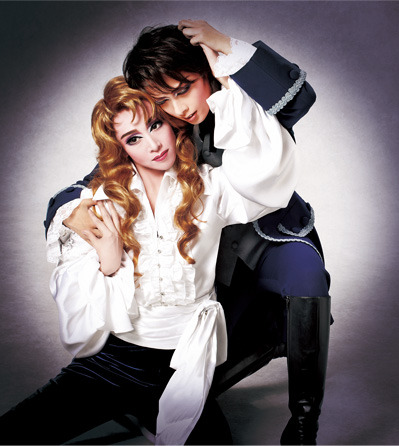
So, the tradition of ‘Kata’ that the late Kabuki actor and even movie star Hasegawa Kazuo provided guidance on for Haruna, the first actress to play Oscar, passed through generations and was inherited by Asumi. Asumi, if you were to star in Berubara now, what role would you want to play?
“I just want to try the scene where Oscar appears in front of Fersen in a dress. It’s tough because Oscar is a tomboy and in other scenes, she’s always fighting (laughs). Prior, I saw in the news that the dress from this scene in the manga was produced, it was so beautiful... That singular dress that she wore, it’s amazing. In Takarazuka, because Oscar tends to be drawn-up maidenesque, the costumes including the mantle are girls’, so they are light and silky, which is a minor point of interest of mine I get really excited about (laughs). I loved the costume with the mantle and light blue military uniform with the pink sash.”
Oscar’s dress will be up for display at the 50th-anniversary exhibition, so it’s a must-see.

“Oscar really has a uniquely special existence, doesn’t she? There’s a line Oscar says, ‘Ahh, God, why did you take this life away to such a far-away, foreign country, after having such a knot tied of us 3 up here on this French soil...!’, but under the French Revolution, really everyone is living such tumultuous lives, and all of it gets tangled together. Events that romantic wouldn’t happen in my own life. But just as much as the characters of this story, I learned about cherishing what binds us together as people, as well as having to keep things such as love and trust with you throughout your life. Ikeda-Sensei drawing this at such an age without even going to France, I find myself asking what the heck was going on inside her head (while looking at the manga). The coloring is amazing! I can’t stop looking anymore (laughs).”
Berubara draws a picture of the 18th-century French royal court’s exceedingly lavish dress and lifestyle, do you dream or yearn for such a culture yourself?
“To an extent I do, because I’m a girl (laughs), after all, I like that dressed-up style with incredible corsetry, I want to imitate it.”
To finish off, with the Rose of Versailles in its 50th year, what do you think the reason is that people continue to love it so much?
“I think the number one reason is the art of the manga’s eternal beauty and the unique drama and story of it all. Then as for the Takarazuka version, wouldn’t it be those feelings and fruits of love of the creators and performers throughout history all becoming one piece of history? I also want to go and reread the manga once more, I’m sure the points you can empathize with and your favorite character change depending on your age and what you’ve experienced. I think The Rose of Versailles will forever be immortal, so I want to enjoy it with everyone going forward as well.”

198 notes
·
View notes
Text
Best Underrated Anime Group B Round 2: #B1 vs #B2
#B1: Coming-of-age story set in a “utopia”
#B2: High school performers
Titles, propagandas, trailers, and poll under the cut!

#B1: From the New World (Shinsekai Yori)
youtube
Summary:
In the town of Kamisu 66, 12-year-old Saki Watanabe has just awakened to her psychic powers and is relieved to rejoin her friends—the mischievous Satoru Asahina, the shy Mamoru Itou, the cheerful Maria Akizuki, and Shun Aonuma, a mysterious boy whom Saki admires—at Sage Academy, a special school for psychics. However, unease looms as Saki begins to question the fate of those unable to awaken to their powers, and the children begin to get involved with secretive matters such as the rumored Tainted Cats said to abduct children.
Shinsekai yori tells the unique coming-of-age story of Saki and her friends as they journey to grow into their roles in the supposed utopia. Accepting these roles, however, might not come easy when faced with the dark and shocking truths of society, and the impending havoc born from the new world.
Propaganda:
Shinsekai Yori is not the flashiest show, or the fastest pace, but the slow and steady build of the horror and mystery will keep you entranced from beginning to end.
At its heart, this show is a coming-of-age story. We follow the protagonist from her childhood to adulthood, with all the messiness in between. From puberty and discovering sexuality, to learning the darker truths of society and having to live with unwanted knowledge, we see through Saki’s eyes. The setting of this world is a post apocalyptic future, and what society has been rebuilt as is one of the main mysteries we discovered.
This show is very complex and dark and sad, but it’s absolutely beautiful. The visuals, backgrounds, character expressions, music all come together to create something truly unique. The only show I know to compare it to might be Psycho-Pass, for it’s similarly deep deconstruction of society. However, whereas Psycho Pass is one of the most praised anime of all time, Shinsekai Yori is barely known. This is a shame, because it truly has something special to say that everyone can relate to. How hard growing up can be, fighting against your own hormones, traditions, adults, family, friends, your moral code.
This is not a happy story; it’s a bittersweet, cautionary tale.
Trigger Warnings: Animal Cruelty or Death, Graphic Depictions of Cruelty/Violence/Gore, Suicide

#B2: Kageki Shoujo!!
youtube
Summary:
After being forced to graduate from JPX48 following a controversial incident with a male fan, Ai Narata swears to never interact with another man ever again. Using her talents and strong desire to get away from men, Ai auditions for the exclusive all-female Kouka School of Musical and Theatrical Arts. The school is renowned for producing the best actresses that go on to perform in the famous all-female Kouka Theatre Troupe. Coming from the idol industry, Ai is the perfect candidate for the school's hundredth generation class, but her aloof demeanor alienates her from her classmates.
The eccentric Sarasa Watanabe is the only person who wishes to become Ai's friend. She enters Kouka with the goal of becoming a top "otokoyaku" performer—an actress that plays traditionally male roles. After seeing a Kouka performance of The Rose of Versailles when she was younger, Sarasa dreams of performing as Lady Oscar one day. Unfortunately, Sarasa's inability to read a room causes friction between her and her classmates, including Ai, who reluctantly becomes her roommate and partner in many of their classes.
Succeeding at Kouka will involve more than just raw talent for these young girls as jealousy, deceit, and the harsh realities of show business put their mental fortitude to the test. Will Sarasa and Ai be able to rise to the top and stand on the silver bridge?
Propaganda:
If theatre setting/schools is your thing, you’re probably going to love this series! We follow our protagonists and their schoolmates following their dreams to become actresses for the prestigious Kouka Revue. Not an easy road as they will have to face and overcome many challenges, the hardest ones coming from themselves. Indeed, the story is not afraid to address sensitive topics and their resulting traumas (see TW list) always rightfully handed. These episodes may be a bit hard to see if you’re sensitive to these topics, but the show never leaves you in discomfort: everything is properly addressed, and characters are cared for realistically.
The characters are all very well-written, portraying individuals with way more depth than they may appear at first glance. We follow their growth—or its start—during the series. Sarasa is a walking sunbeam, and her blooming friendship with the withdrawn Ai is a delight to watch. We learn to know—and love—all their classmates as well, as episodes switch focus to one or the other.
The OST is really good, with a catchy opening, and no less than five different versions of the ending song, a fabulous duet voiced by the cast! The animation features really pretty art with iconic details like the stars in Sarasa’s eyes. The series is a homage to Takarazuka and scatter references to famous real-life Revues and older famous shôujo manga series like “Versailles no Bara” or “Glass no Kamen”. Actually, it feels like a modernized version of their essence: roses, sparkles, spotlight, drama, all while staying safe!
This anime is like candy for eyes and soul, and I really hope we'll get a season 2 to explore the girls' voices further!
Trigger Warnings: Child Abuse, Pedophilia, Self-Harm
Nothing is too graphical nor explicit, just the right amount to let the unsettling situations be clear enough to watchers, and they’re always addressed correctly.
Child abuse/ Pedophilia: episode 3 (+4), about Ai’s traumas
Self-harm: episode 5 focuses on a girl with an eating disorder, forcing herself to vomit (not sure if that really counts as TW?)

When reblogging and adding your own propaganda, please tag me @best-underrated-anime so that I’ll be sure to see it.
If you want to criticize one of the shows above to give the one you’re rooting for an advantage, then do so constructively. I do not tolerate groundless hate or slander on this blog. If I catch you doing such a thing in the notes, be it in the tags or reblogs, I will block you.

Know one of the shows above and not satisfied with how they’re presented in this tournament? Just fill up this form, where you can submit revisions for taglines, propaganda, trigger warnings, and/or video.
#anime#best underrated anime#polls#poll tournament#tournament#anime tournament#animation#group stage#group stage round 2#tournament polls#from the new world#shin sekai yori#shinsekai yori#kageki shoujo#kageki shoujo!!#group b
21 notes
·
View notes
Note
Is there a list of frev figures who claimed to be at the storming of the Bastille? The people I know who said they at least witnessed it is pretty eclectic like Herault, Léon and Saint-Just.
I found all the (official?) ”vainqueurs de la Bastille” listed in alfabethical order here (1889). However, according to Michael J. Sydenham’s Léonard Bourdon: The Career of a Revolutionary, 1754-1807, who’s subject of study claimed to belong to this group, simply holding this title was not a guarantee that you had actually taken part in the storming itself:

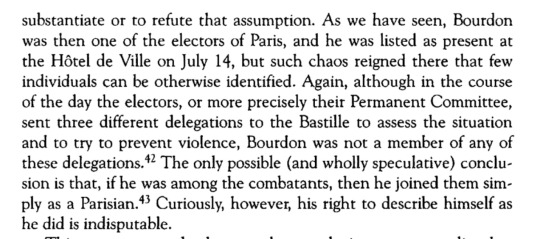
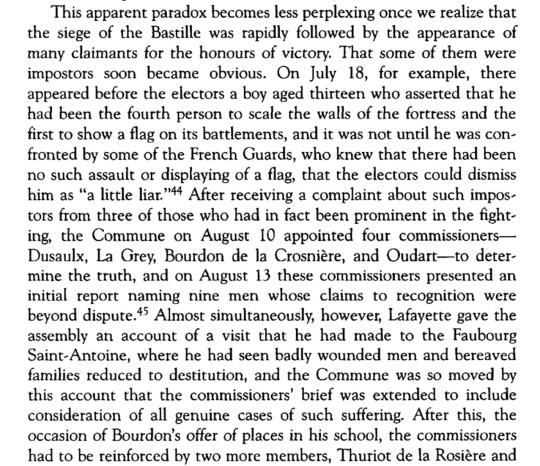


The only people found on the list that I myself recognized were those of the dantonist Louis Legendre, the girondin Claude Fauchet and the general Antoine Joseph Santerre. I therefore don’t know if the people claiming to have participated in the storming here below are just lying (saying you played a role in it after all being something that would easily better your patriotic reputation) or if their participation just wasn’t recorded (which doesn’t sound particulary hard to be true either):
Stanislas Fréron claims in a letter to Lucile Desmoulins dated October 18 1793, that both he, Barras and La Poype ”besieged” the Bastille.
Pierre Nicolas Berryer wrote in his memoirs that the Convention deputy Bourdon d’Oise participated in the storming of the Bastille, and still kept the blood stained coat he had worn during it five years later:
At the same time, and as if he felt the need to convince me even more of the strength of his mind, [Bourdon] took out from under his bed an oblong casket, in which was tucked the coat he had worn on the day of the storming of the Bastille… […] He took great care to point out to me that his coat was still covered with stains from the blood he had spilled at the Bastille.
Albert Mathiez summarized in the article La vie de Héron racontée par lui-même (1925) a memoir the Committee of General Security spy François Héron wrote while imprisoned after thermidor. In it, he would have claimed to have participated in the storming of the Bastille, as well as the women’s march on Versailles, the demonstration of June 20 and the Insurrection of August 10.
According to Dictionnaire des parlementaires français (…) de 1789 à 1889, Jacques-Alexis Thuriot took part in the storming.
Regarding some more well known guys and their Bastille activities, Desmoulins, in a letter written to his father written July 16, leaves a rather detailed description of the storming. Through the following part, he does however indicate that he himself missed it:
Then, the cannon of the French Guards made a breach. Bourgeois, soldiers, everyone rushes forward. An engraver climbs up first, they throw him down and break his legs. A luckier French guard followed him, seized a gunner, defended himself, and the place was stormed in half an hour. I started running at the first cannon shot, but the Bastille was already taken, in two and a half hours, a miracle that is.
Camille also adds that, on July 15, he was among the people who scaled the ruins of the stormed Bastille:
However, I felt even more joy the day before, when I climbed into the breach (montai sur la brèche) of the surrendered Bastille, and the flag of the Guards and the bourgeois militias was raised there. The most zealous patriots were there. We embraced each other, we kissed the hands of the French guards, crying with joy and intoxication.
On July 23 1789, Robespierre wrote a letter to Antoine Buissart telling him he had gotten to see the ”liberated” Bastille, but he had of course not participated in the storming himself:
I’ve seen the Bastille, I was taken there by a detachment of the brave bourgeois militia that had taken it; because after leaving town hall, on the day of the king's trip, the armed citizens took pleasure in escorting out of honor the deputies they met, and they could only march among acclamations from the people. What a delightful abode the Bastille has been since it came into the power of the people, its dungeons are empty and a multitude of workers work tirelessly to demolish this odious monument to tyranny! I could not tear myself away from this place, the sight of which only gives sensations of pleasure and ideas of liberty to all good citizens.
According to Danton: le mythe et l’histoire (2016), Danton did not take part in the actual storming of the Bastille, however, the following day he went to the abandoned prison and took the provisional governor hostage:
Absent from the storming of the Bastille, it was on the night of July 15 to 16 that Danton took action. At the head of a patrol of the bourgeois guard of his district, of which he proclaimed himself captain, he claimed, we do not know in what capacity, to enter the "castle of the Bastille,” placed under the control of the elector Soulès, as provisional governor. Without worrying about his powers, Danton has him kidnapped and taken to City Hall, surrounded by a threatening crowd. But Soulès was released the next day upon the intervention of La Fayette; Danton's initiative was openly disavowed and blamed by the assembly of electors.
According to Clifford D. Connor, Marat wrote the following about his activities on July 14 1789 in number 36 of l’Ami du peuple (12 November 1789):

#lots of thermidorians who were involved in the storming…#french revolution#frev#bastille#danton was really unhinged here…
25 notes
·
View notes
Note
Ok I'll bite. What is kageki shoujo about
(I did look it up! It's just that imo those synopses tend to be misleading or incomplete in one way or another... If you wouldn't mind, then asking someone is better)
i'd love to explain!!!
have you heard about takarazuka revue? it is an all-female japanese theater troupe founded in the 1910s that perform extravagant broadway-like musicals, where both female (musume-yaku) and male (otoko-yaku) roles are played by women. it's a counterpart of sorts to kabuki, a classic form of japanese theater where only men are allowed to perform.
most of their productions are adapted from western literature or manga, and their most iconic play is based on the rose of versailles, a manga about the french revolution. our protagonist in kageki shoujo is sarasa, a 15 year old girl whose dream is to be the main character in that play. and to achieve that, she joins the troupe's boarding school to learn theater! though in this anime takarazuka is named kouka for some reason
it is a highly demanding and competitive environment, so the manga treats sensitive themes such as csa, eating disorders or stalking. they're well-handled but quite triggering to watch so im warning you in advance 🫡 (there might be a couple of other things of note in the manga only, but i haven't read that far yet)
and if you've read synopses you might have also heard about sarasa's counterpart and other main character, ai, a girl who was forced to quit her idol group after a scandal and enrolled the school as well. the show focuses on these two, but also their classmates and some seniors. the characters all have really interesting and developed storylines, i really enjoyed that aspect of it
so, to sum it up, kageki shoujo is a slice of life drama manga about a musical theater school! the anime is a really good adaptation too that i definitely recommend checking out. adds build up in just the right places and everyone's singing voices are wonderful, even if it cuts out some things here and there. really really good piece of media as a whole


^ the main girls!!!
extra note: if you look up the manga, you'll notice there is kageki shoujo: the curtain rises and kageki shoujo!!. you have to read curtain rises first, they're separate mangas because there were some magazine publishing problems. the anime is titled kageki shoujo!!
#very nice cast very nice story very nice execution#def recommended#i watched the anime first and am now reading the manga and it's a pretty good order 👍#kageki shoujo#kageki shoujo!!#anonymous#preguntas
13 notes
·
View notes
Text

₍ ⌨ [aquaticlime] is typing ... ₎
˗ˏˋMOVIE IDEAS´ˎ˗
In no particular order here are some projects I Star or just take part in.
Feel free to use these ideas for your own DR, not all of these are my own original ideas, I borrowed some from TikTok.
|‘𝑩𝒂𝒕𝒕𝒍𝒆 𝑹𝒐𝒚𝒂𝒍𝒆’|

"A group of treasure hunters race against rival teams to find a hidden treasure in an ancient temple, but they soon discover that the temple contains a powerful entity that will stop at nothing to defend its treasure. Suspense, adventure, and danger ensue as the treasure hunters face off against not only other teams but also the power of the ancient temple's protective entity. Exciting and thrilling, ‘Battle Royale’ is sure to be an action-packed and adrenaline-fueled adventure."
|‘𝑺𝒖𝒎𝒎𝒆𝒓 𝒐𝒇 𝑳𝒐𝒗𝒆’ |

"Set in the heart of the 1960s counterculture revolution, follow a couple of young free spirits as they find themselves at the iconic Woodstock festival, As the music plays on and the world around them transforms before their eyes. Set amidst the music that inspired a generation, enjoy the heartwarming tale of love and discovery as our couple takes a chance to follow their hearts and embrace a connection they never knew possible."
|‘𝑬𝒏𝒄𝒉𝒂𝒏𝒕𝒓𝒆𝒔𝒔: 𝑺𝒂𝒗𝒂𝒈𝒆 𝑶𝒓𝒊𝒈𝒊𝒏𝒔’|

“Archeologist Dr. June Moone uncovers an ancient artifact, unleashing a spirit hailing from another dimension. This leads to a dangerous and thrilling adventure deep into the jungles of Peru, where she must fight for survival as well as uncover the hidden truths behind the her newfound superhuman abilities. Suspense, action, and mystery abound as ancient truths behind the entity’s origins come to light, after millennia in the dark.”
|‘𝑷𝒂𝒓𝒕𝒚 𝒇𝒐𝒖𝒍’ |

"A hilarious and entertaining comedy-drama that perfectly captures the comedic and dramatic side of roommate living. With engaging conflicts and amusing misunderstandings, the movie follows a group of roommates who try to throw a surprise birthday party for their difficult but beloved landlord. ‘Party Foul’ successfully balances the chaos and craziness of living with roommates while also highlighting the importance of friendship and empathy. It's a wonderfully entertaining and heartwarming tale that leaves viewers with satisfaction and delight."
|‘𝑫𝒐𝒖𝒃𝒍𝒆 𝒃𝒐𝒐𝒌𝒆𝒅’|

“A group of friends decide to take a trip to a vacation spot, but they soon realize that their hotel has been double-booked and they must compete with another group for the best rooms and amenities. Comedy and competition ensue as both parties fight for the best accommodations while also trying to enjoy their holiday, resulting in a hilarious and action-packed vacation experience."
|‘𝑴𝒂𝒊𝒅 𝒕𝒐 𝒃𝒆 𝑭𝒖𝒏𝒏𝒚’|

"In this hilarious and heartfelt tale, enter the extravagant world of Versailles Palace, where our band of maidens work tirelessly in the background to provide the essential services that keep the palace of Versailles running smoothly and the royals satisfied. Despite their seemingly minor role in the court hierarchy, they soon discover that their presence is not limited to just scrubbing floors and polishing silver. Amid the eccentric demands of their employers and the constant struggle to keep up with the court's social dynamics, our maids find a way to carve out their own space and make a name for themselves in this wild and luxurious world. Full of humor and hijinks, this comedic story is sure to entertain readers of all ages.”
╰─▸ @[aquaticlime] has
. . . . logged off
˗ˏˋReturn to masterlist ✦ main masterlist´ˎ˗
#shifting to desired reality#shifting consciousness#shifting motivation#shifting community#reality shifting#desired reality#shifting blog#shiftblr#fame dr#actress dr
12 notes
·
View notes
Text
Le Maréchal Berthier : Pilier de l'Empire Napoléonien
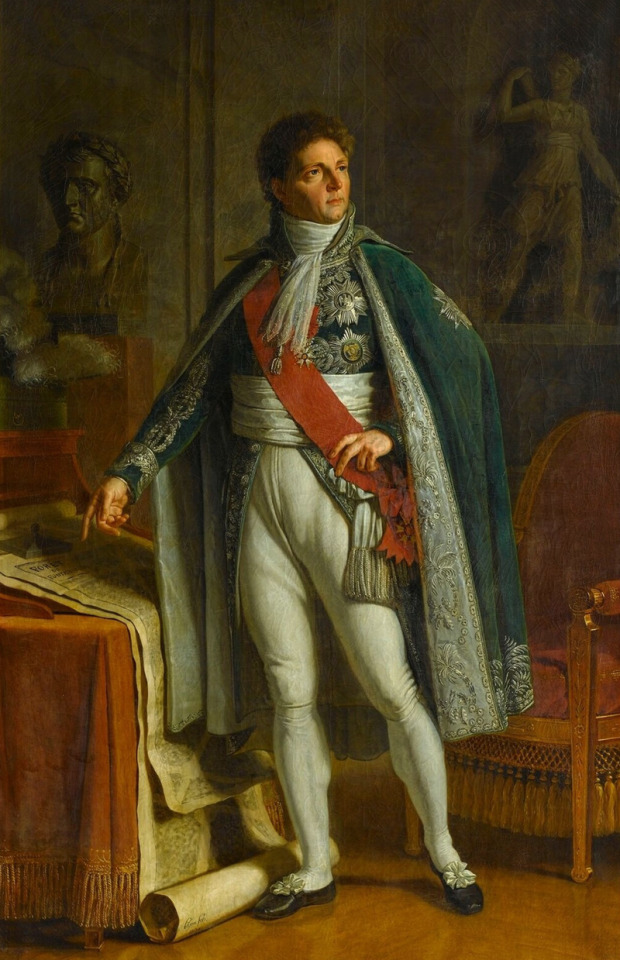
Né le 20 novembre 1753 à Versailles, Louis Alexandre Berthier est bien plus qu'un simple militaire. Sa destinée est intimement liée à celle de Napoléon Bonaparte, forgeant ainsi une alliance indéfectible au service de la France.
Dès son jeune âge, Berthier se distingue par son esprit vif et son dévouement à la patrie. Son ascension fulgurante au sein de l'armée française le mène rapidement à croiser la route du futur Empereur des Français.
Berthier participe sous les ordres de Bonaparte aux campagnes d'Italie puis d'Égypte et soutient le coup d'État du 18 Brumaire.
En tant que chef d'état-major de Napoléon, Berthier joue un rôle crucial dans la planification et l'exécution des campagnes militaires qui ont marqué l'histoire. Sa rigueur tactique et son génie organisationnel contribuent grandement aux victoires éclatantes de l'Empire, malgré son incapacité à diriger lui-même une armée.
La mort tragique de Berthier en 1815, suite à une chute mystérieuse d'une fenêtre de l'hôtel de son épouse à Bamberg, laisse un vide profond dans l'entourage de Napoléon.
Son décès précède en effet de quelques jours la bataille de Waterloo, où l'absence de cet excellent chef d'état-major se fait cruellement sentir pour l'Empereur qui dira de lui : "Nul autre n'eût pu le remplacer"
Berthier décide pourtant de suivre Louis XVIII lors de la Restauration, et adhére même au décret du Sénat qui exclut Napoléon du trône.
***
L'héritage du maréchal Berthier perdure à travers les pages de l'histoire. Son influence indélébile sur la stratégie militaire et l'administration de l'Empire demeure incontestée, faisant de lui l'un des piliers incontournables de l'épopée napoléonienne.
***
Marshal Berthier: Pillar of the Napoleonic Empire
Born on November 20, 1753, in Versailles, Louis Alexandre Berthier is much more than a mere military figure. His destiny is intimately intertwined with that of Napoleon Bonaparte, thus forging an unbreakable alliance in service to France.
From a young age, Berthier distinguished himself with his sharp intellect and dedication to his homeland. His rapid ascent within the French army quickly led him to cross paths with the future Emperor of the French.
Berthier participated under Bonaparte's command in the campaigns in Italy and Egypt, and supported the coup d'état of the 18th Brumaire.As Napoleon's chief of staff, Berthier played a crucial role in the planning and execution of military campaigns that have left an indelible mark on history. His tactical rigor and organizational genius greatly contributed to the Empire's resounding victories, despite his own inability to lead an army himself.
The tragic death of Berthier in 1815, following a mysterious fall from a window of his wife's hotel in Bamberg, left a profound void in Napoleon's inner circle.Indeed, his death preceded by a few days the Battle of Waterloo, where the absence of this excellent chief of staff was keenly felt by the Emperor who said of him: "No other could have replaced him."
However, Berthier decided to follow Louis XVIII during the Restoration, and even adhered to the Senate decree which excluded Napoleon from the throne.
***
The legacy of Marshal Berthier endures through the pages of history. His indelible influence on military strategy and the administration of the Empire remains unquestioned, making him one of the indispensable pillars of the Napoleonic epic.
#bonaparte#france#napoleon#napoleon bonaparte#guerre#soldats#Maréchal#Berthier#louis alexandre berthier#napoleonic wars#napoleonic era#napoleonic
20 notes
·
View notes